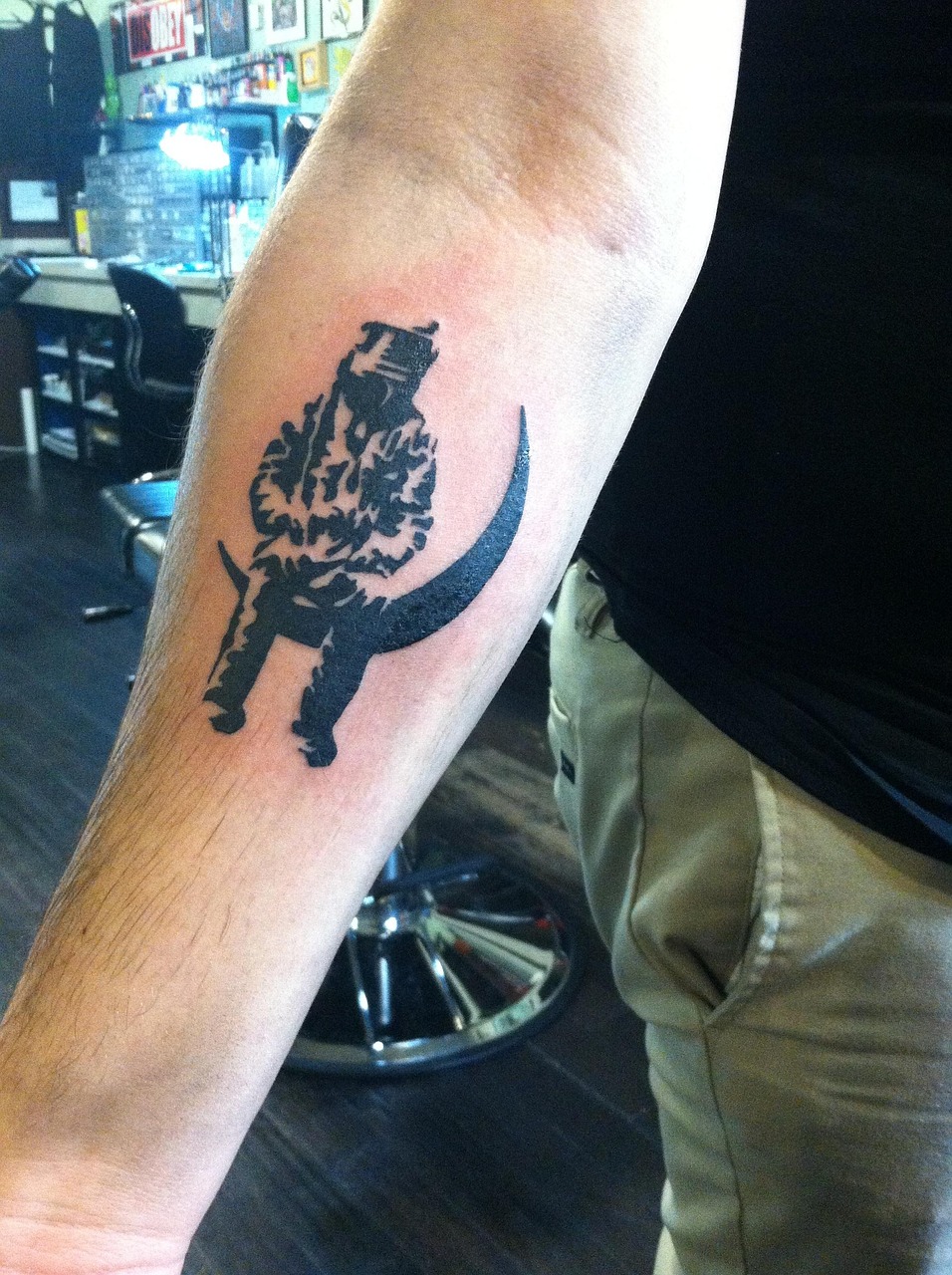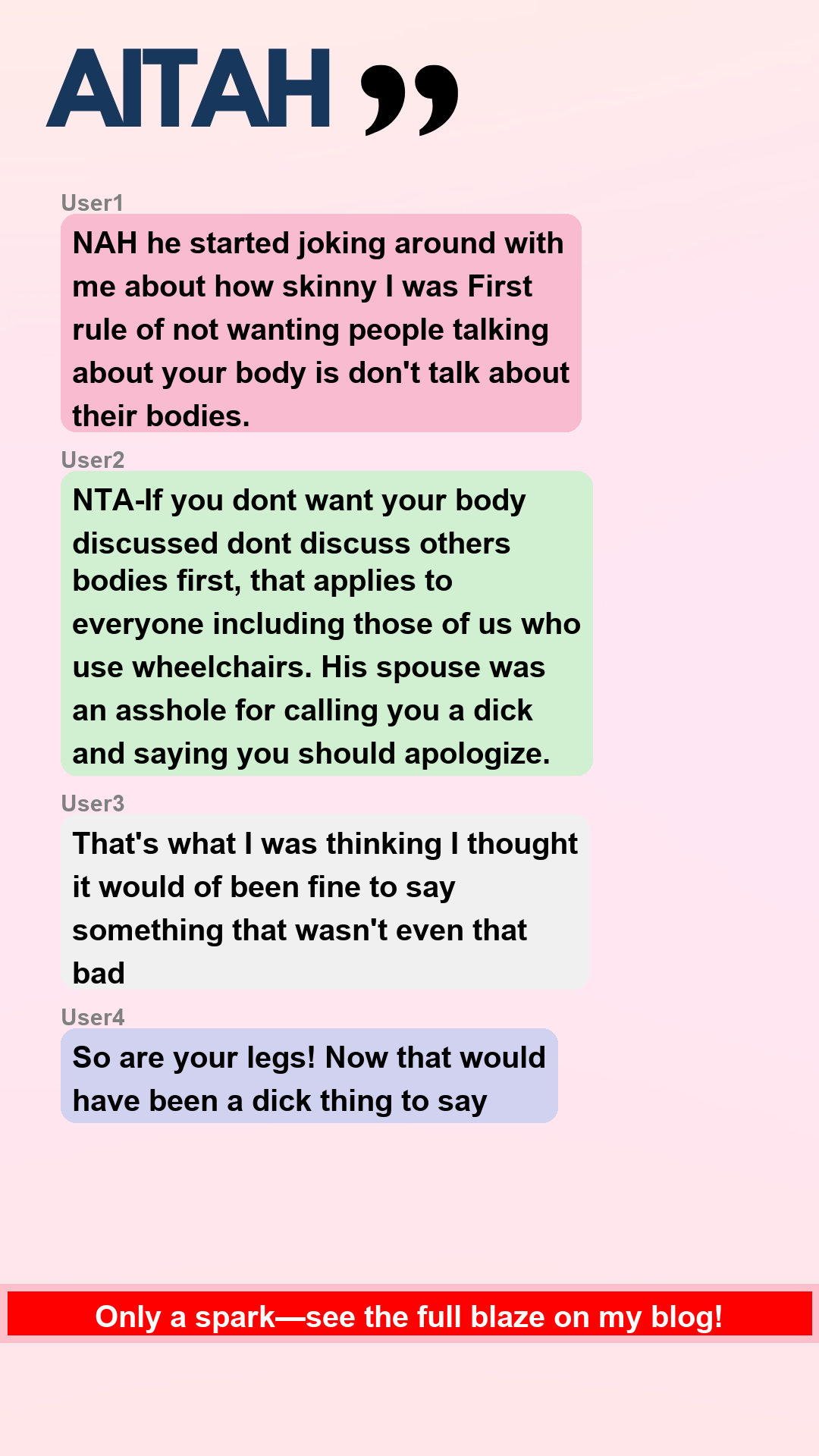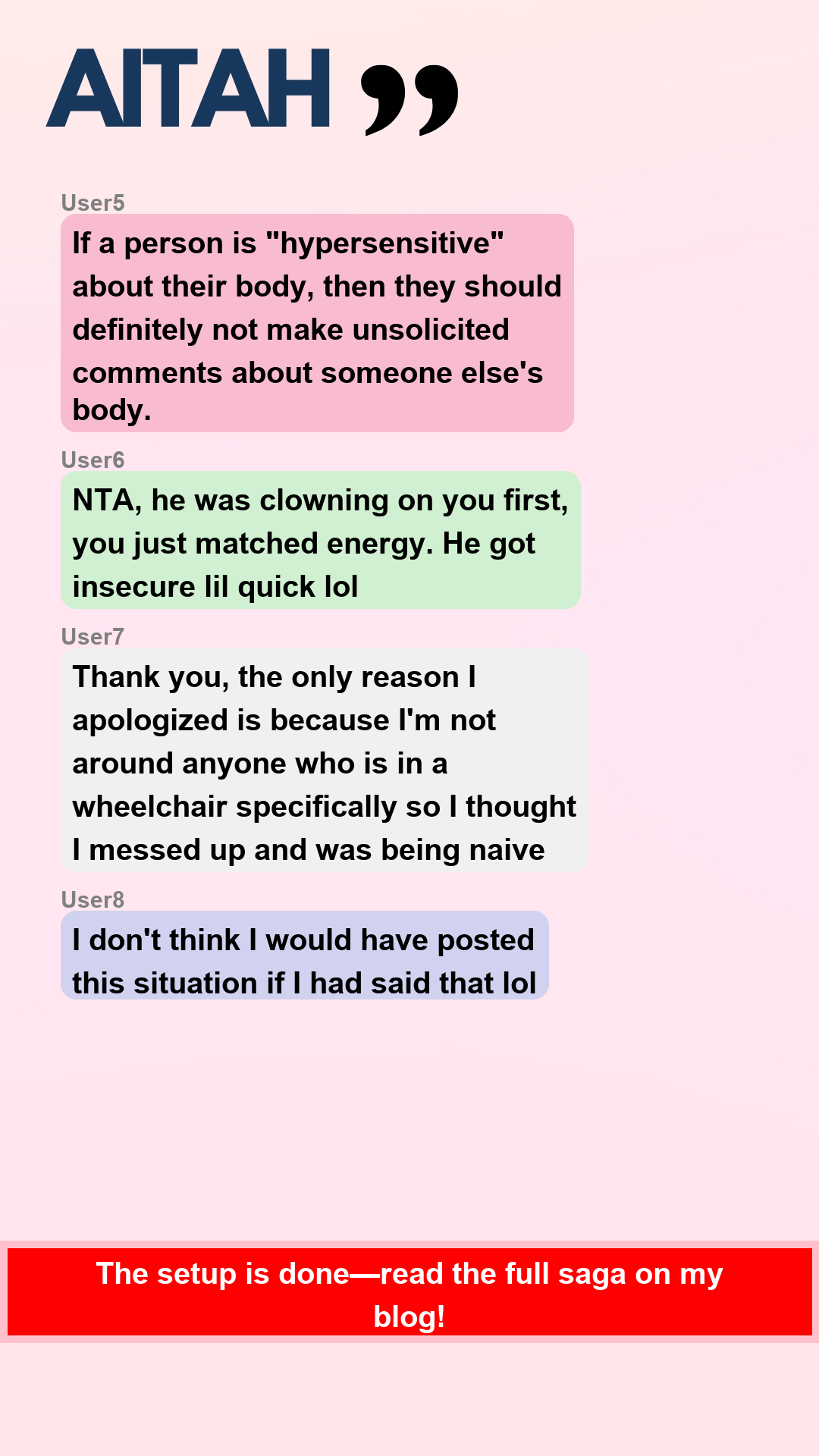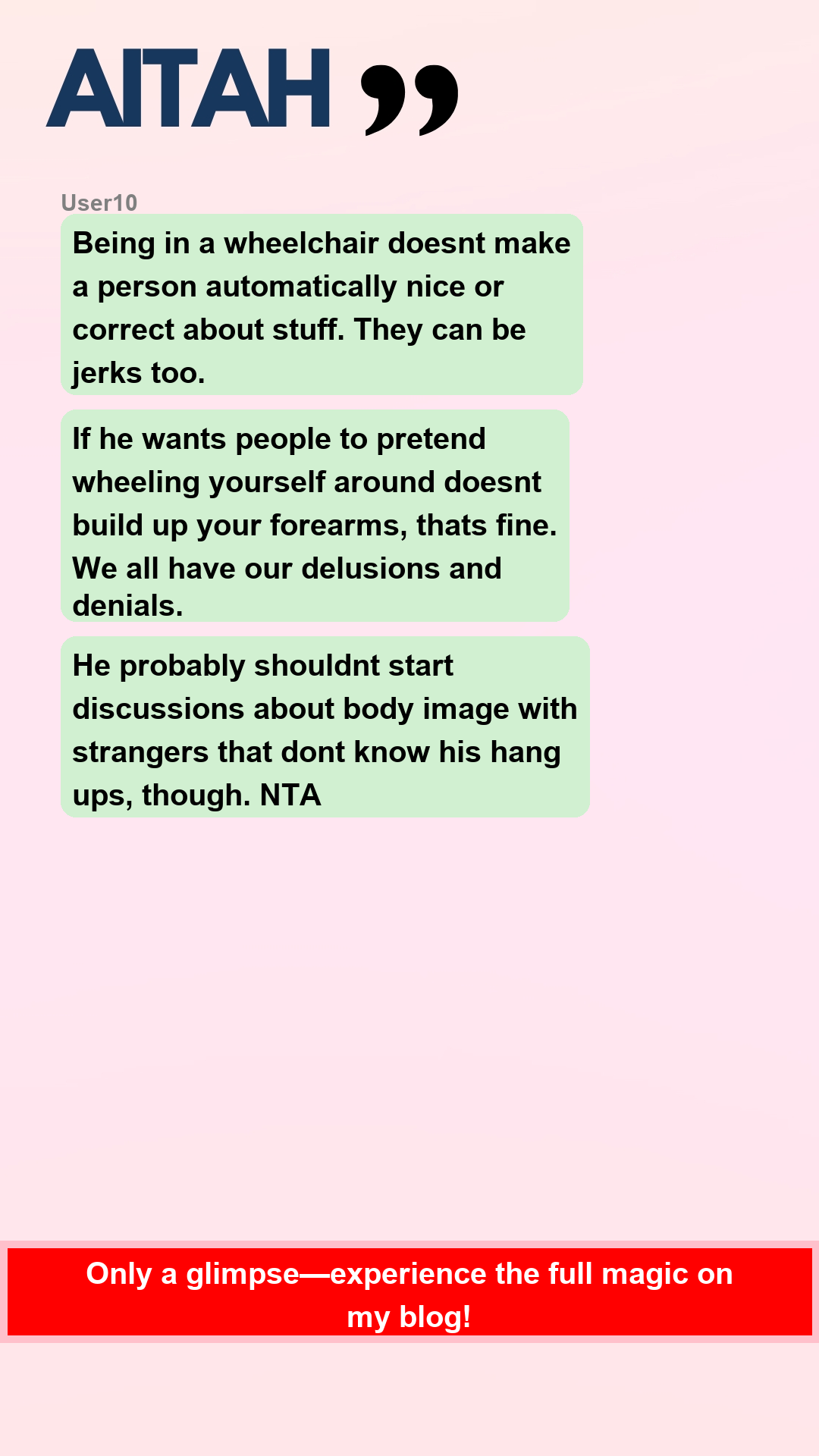AITA for telling a dude in a wheelchair that he has big forearms?
 Image credit: Pixabay (This is example image – Not the actual photo)
Image credit: Pixabay (This is example image – Not the actual photo)
AITA for Commenting on a Stranger’s Forearms?
When a young man strikes up a lighthearted conversation with a person in a wheelchair, he thinks he’s just sharing a laugh—until a seemingly innocent compliment takes a turn. After joking about each other’s physiques, his comment about the other man’s forearms leads to an unexpected fallout. This encounter raises questions about sensitivity, intent, and the complexities of social interactions, making it a relatable scenario for anyone who’s ever faced the consequences of a misunderstood remark.
- Relatable Dilemma: Navigating social cues can be tricky, especially when humor is involved.
- Thought-Provoking: It challenges readers to consider the impact of their words and the importance of context.
Family Drama and Conflict Resolution in a Grocery Store Encounter
In a recent incident that sparked some family drama, a young man, 21, found himself in an unexpected conflict while shopping at a grocery store. The situation unfolded as follows:
- Initial Encounter: The young man noticed an individual in a wheelchair and struck up a conversation. They exchanged light-hearted jokes, with the young man commenting on his own slim physique.
- Comment Misunderstood: In a playful response, the young man remarked on the size of the wheelchair user’s forearms, intending it as a compliment. However, the comment was not received well, and the wheelchair user’s demeanor changed abruptly.
- Immediate Reaction: The wheelchair user smiled initially but then rolled away, leaving the young man confused about the sudden shift in mood.
- Confrontation: A few minutes later, the wheelchair user’s spouse approached the young man. They expressed their discontent with the comment, labeling it as inappropriate and offensive.
- Apology Offered: Despite feeling that his comment was harmless, the young man chose to apologize to the spouse, wanting to diffuse the tension and avoid further conflict.
- Reflection: After the encounter, the young man felt conflicted about the situation. He believed his intention was not malicious and questioned whether he was truly in the wrong.
This incident highlights the complexities of communication and the potential for misunderstandings, especially in sensitive contexts. The young man’s experience serves as a reminder of the importance of being mindful of how comments may be perceived, particularly in situations involving individuals with disabilities.
As family drama often arises from such conflicts, it is crucial to engage in open dialogue for effective conflict resolution. Understanding different perspectives can help prevent similar tensions in the future, especially in social settings like weddings or family gatherings where emotions may run high.
This is Original story from Reddit
 Image credit: Pixabay (This is example image – Not the actual photo)
Image credit: Pixabay (This is example image – Not the actual photo)
Story
I, a 21-year-old, was walking in a grocery store when I saw someone in a wheelchair. We were having a conversation when he started joking around with me about how skinny I was, not in a bad way. I exclaimed that his forearms were huge.
His smile quickly faded, and then he rolled away. His spouse came over and found me a few minutes later. She told me that I was a jerk for saying that and that I should apologize.
I ended up apologizing, but I felt like I wasn’t in the wrong.
View the Original Reddit Post Here
Summary of Reddit Comments
The top Reddit comments indicate a general agreement that the original commenter is not at fault (NTA) for responding to body comments with a similar remark. Many users emphasize that if someone makes unsolicited comments about another’s body, they should be prepared for a response, especially if they are sensitive about their own body image. The consensus suggests that the spouse’s reaction was unwarranted, and the situation highlights the complexities of discussing body image in social interactions.
Verdict: NTA
Expert Advice for Resolving the Conflict
Conflicts like the one described can be challenging, especially when they involve sensitive topics such as body image and disabilities. Here are some practical steps for both the young man and the wheelchair user’s spouse to help resolve the situation and foster understanding:
For the Young Man
- Reflect on Intent vs. Impact: Take time to consider how your words may have been perceived, regardless of your intentions. Understanding the impact of your comments can help you communicate more effectively in the future.
- Reach Out for Clarification: If possible, consider reaching out to the wheelchair user or their spouse to express your desire to understand their perspective better. A simple message acknowledging the misunderstanding can go a long way.
- Educate Yourself: Take the opportunity to learn more about disability awareness and body image issues. This knowledge can help you navigate similar situations with greater sensitivity in the future.
For the Wheelchair User’s Spouse
- Communicate Openly: While it’s important to express your feelings, try to approach the situation with an open mind. Consider discussing your concerns directly with the young man, allowing for a dialogue rather than a confrontation.
- Practice Empathy: Recognize that the young man may not have intended to offend. Understanding that misunderstandings can happen can help you respond with compassion rather than anger.
- Encourage Positive Dialogue: Use this experience as a teaching moment for both yourself and the young man. Share your feelings about body image and how comments can affect individuals differently, fostering a more supportive environment.
For Both Parties
- Engage in Active Listening: When discussing the incident, ensure that both sides feel heard. Listening actively can help de-escalate tensions and promote understanding.
- Seek Common Ground: Focus on shared experiences or feelings rather than differences. Finding common ground can help build rapport and reduce conflict in the future.
- Consider Mediation: If direct communication proves difficult, consider involving a neutral third party to facilitate the conversation. This can help both sides express their feelings in a safe environment.
By taking these steps, both the young man and the wheelchair user’s spouse can work towards resolving the conflict and fostering a more understanding and respectful relationship moving forward. Remember, open dialogue and empathy are key components in navigating sensitive topics.
Join the Discussion
 Image credit: Pixabay (This is example image – Not the actual photo)
Image credit: Pixabay (This is example image – Not the actual photo)
What do you think? Would you have handled this differently?
Share your thoughts below! Vote: Do you agree with Reddit’s verdict?




